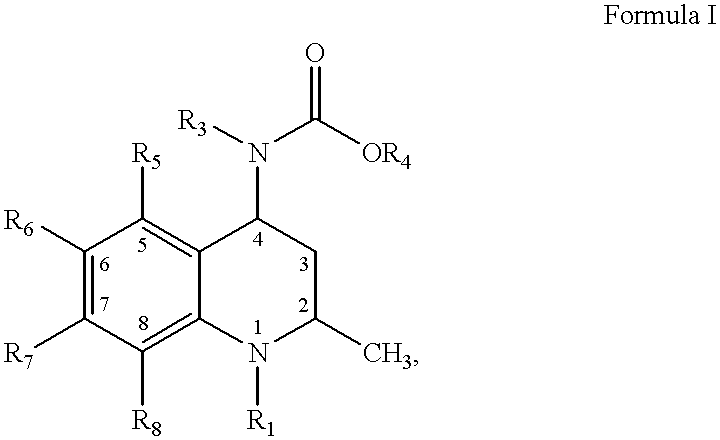Oxy substituted 4-carboxyamino-2-methyl-1,2,3,4-tetrahydroquinolines
a technology of hdl-cholesterol and oxy substituted quinolines, which is applied in the direction of biocide, drug composition, metabolic disorders, etc., can solve the problems of reducing compliance, reducing the effect of hdl-elevating therapies, and negatively correlated hdl-cholesterol levels
- Summary
- Abstract
- Description
- Claims
- Application Information
AI Technical Summary
Problems solved by technology
Method used
Image
Examples
example 2a
4-Benzylimino-6,7-dimethoxy-2-methyl-3,4-dihydro-2H-quinoline-1-carboxylic Acid Benzyl Ester
6,7-Dimethoxy-2-methyl-4-oxo-3,4-dihydro-2H-quinoline-1-carboxylic acid benzyl ester (0.83 g, 2.3 mmol) was dissolved in a solution of triethylamine (2.2 mL, 2.3 mmol), benzylamine (0.55 mL, 5.1 mmol), and anhydrous dichloromethane (15 mL). This solution was stirred in a room temperature water bath as 2.5 mL of 1M solution of titanium tetrachloride (TiCl.sub.4) in dichloromethane (2.5 mmol) was slowly added. The reaction was allowed to stir at room temperature for 48 h. The reaction mixture was then poured into a stirred solution of water (50 mL) and potassium carbonate (10 g). After filtration, the filtrate was extracted with ethyl acetate (3.times.100 mL), the combined organic phases washed with water (100 mL), brine (50 mL), dried over sodium sulfate, filtered, and concentrated in vacuo to give the desired imine (1.12 g, ca.100%). .sup.1 H NMR (CDCl.sub.3) .delta.1.2 (d, 3H), 2.7-2.9 (m, 2...
example 2b
cis-4-Benzylamino-6,7-dimethoxy-2-methyl-3,4-dihydro-2H-quinoline-1-carboxylic Acid Benzyl Ester
4-Benzylimino-6,7-dimethoxy-2-methyl-3,4-dihydro-2H-quinoline-1-carboxylic acid benzyl ester (1.02 g, 2.29 mmol) was dissolved in ethanol (12 mL), and sodium borohydride (96 mg, 2.5 mmol) was added. After the reaction was stirred overnight, additional sodium borohydride (43 mg, 1.1 mmol) was added, and the reaction was stirred for 20 min. The reaction mixture was then concentrated in vacuo to about 8 mL and then neutralized with 1N HCl. The mixture was extracted with ethyl acetate (3.times.12 mL). The organic phases were combined and washed with water (10 mL), brine (5 mL), dried over sodium sulfate, filtered, and concentrated in vacuo to give 1.07 g of a crude mixture of product amines. Purification by silica gel chromatography using 0-20% ethyl acetate / hexanes as eluent afforded the cis amine (160 mg, 16%). .sup.1 H NMR (CDCl.sub.3) .delta.1.1-1.3 (m, 4H), 2.6 (ddd, 1H), 3.5 (dd, 1H), 3...
example 3a
4-Hydroxyimino-6,7-dimethoxy-2-methyl-3,4-dihydro-2H-quinoline-1-carboxylic Acid Ethyl Ester
A stirred solution of 6,7-dimethoxy-2-methyl-4-oxo-3,4-dihydro-2H-quinoline-1-carboxylic acid ethyl ester (10.0 g, 34.1 mmol), hydroxylamine hydrochloride (7.1 g, 102 mmol), and sodium acetate (7.0 g, 85 mmol) in ethanol (50 mL) was heated at reflux for 2 h. Water (50 mL) was added, and the volatiles were removed in vacuo. Ethyl acetate (175 mL) was added, and the mixture was stirred vigorously for 10 min. The aqueous phase was separated and extracted with ethyl acetate (2.times.60 mL). The combined organic layers were washed with brine (25 mL), dried over magnesium sulfate, filtered and concentrated in vacuo to give the title compound as a white foam (12.28 g, ca. 100%). .sup.1 H NMR (CDCl.sub.3) .delta.1.1 (d, 3H), 1.32 (t, 3H), 2.77 (dd, 1H), 3.07 (dd, 1H), 3.89 (s, 6H), 4.2-4.4 (m, 2H), 5.0 (m, 1H), 7.18 (s, 1H), 7.26 (s, 1H).
PUM
| Property | Measurement | Unit |
|---|---|---|
| temperature | aaaaa | aaaaa |
| temperature | aaaaa | aaaaa |
| temperature | aaaaa | aaaaa |
Abstract
Description
Claims
Application Information
 Login to View More
Login to View More - R&D
- Intellectual Property
- Life Sciences
- Materials
- Tech Scout
- Unparalleled Data Quality
- Higher Quality Content
- 60% Fewer Hallucinations
Browse by: Latest US Patents, China's latest patents, Technical Efficacy Thesaurus, Application Domain, Technology Topic, Popular Technical Reports.
© 2025 PatSnap. All rights reserved.Legal|Privacy policy|Modern Slavery Act Transparency Statement|Sitemap|About US| Contact US: help@patsnap.com



